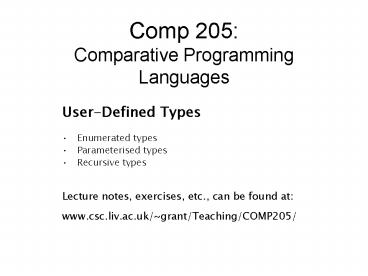Comp 205: Comparative Programming Languages PowerPoint PPT Presentation
1 / 18
Title: Comp 205: Comparative Programming Languages
1
Comp 205Comparative Programming Languages
- User-Defined Types
- Enumerated types
- Parameterised types
- Recursive types
- Lecture notes, exercises, etc., can be found at
- www.csc.liv.ac.uk/grant/Teaching/COMP205/
2
Introducing Constants
- Often it is useful to declare constants in
programs - to make the program easier to read, and/or
- to group related definitions together
- In Java, we might declare
public static final NORTH 0 public static
final EAST 1 public static final SOUTH
2 public static final WEST 3
3
Turning 90º
Because the constants are just names for
integers, code can be hard to follow
public int turn(int direction) direction
if (direction lt 0) (3 lt direction) return
NORTH return direction
4
Turning 90º Again
Not referring to the representation (int),
makes the code easier to follow
public int turn(int direction) switch
(direction) case NORTH return EAST
case EAST return SOUTH case SOUTH
return WEST default return NORTH
5
Putting on the Style
Haskell allows the programmer to define types
data CardinalPoint North East South West
The interpreter treats these as new values of a
new type
Maingt t East East CardinalPoint Maingt
East ERROR - cannot find "show" function ...
6
Deriving Classes
data CardinalPoint North East South
West deriving (Eq, Show)
Maingt East East Maingt East West False
7
Constructor Review
- "" and "" are constructors for lists
- they are primitive operators (i.e., not
evaluated) - all lists are built from these operators(and
elements of the "parameter type")
8
Some Constructors
Bool True and False a and (a,b)
(_,_) Char 'a', 'b', ...
9
Enumerated Types
Types defined to have only constants are
referred to as enumerated types
data Colours Red Orange Yellow
Green Blue Purple -- Bool is a
built-in enumerated type -- -- data Bool True
False
10
True and False
The type Bool is a built-in enumerated type, with
constructors True and False these can be used in
pattern-matching
not Bool -gt Bool not True False not False
True
11
Constant Constructors
The constants in enumerated types
are constructors, and can be used in
pattern-matching
turn CardinalPoint -gt CardinalPoint turn
North East turn East South turn South
West turn West North
Maingt turn East South
12
Constructors with Args
Often we need types where the constructors take
arguments
data Point Pt (Int,Int) deriving (Show)
Maingt Pt (3,6) Pt (3,6) Maingt t Pt (3,6) Pt
(3,6) Point maingt t Pt Pt (Int,Int) -gt
Point
13
Constructors with Args
Constructors can be used in pattern-matching
data Point Pt (Int,Int) deriving (Show) getX
Point -gt Int getX (Pt (x,y)) x
Maingt getX (Pt (3,6)) 3
14
Constructor Curry
We can use currying for constructors that
take more than one argument
data IntString IS Int Char getString
IntString -gt Char getString (IS n s) s
Maingt getString (IS 7 "prosper") prosper
15
Type Parameters
Types can be defined over arbitrary types using
type variables
data ThingAtPoint a At (a,Point) deriving Show
Maingt t At(0Int, Pt(2,4)) ... ThingAtPoint
Int Maingt t At("begin", Pt(2,4)) ...
ThingAtPoint Char
16
More Type Parameters
Types that have more than one type parameter use
more than one type variable
data ThingAndList a b TL a b deriving
Show getList ThingAndList a b -gt b getList
(TL t l) l
Maingt getList (TL 7 "prosper") prosper
17
Polymorphism
Parameterised definitions allow
polymorphic functions
data IntList a IL Int a deriving
Show mapList (a -gt b) -gt
IntList a -gt IntList b mapList f (IL n l) IL n
(map f l)
Maingt mapList ord (IL 7 "abc") NL 7 97,98,99
18
Summary
- Users (programmers) can define types
byspecifying constructors and their types - these types are distinct from all other
types(and constructor names should not be
reused) - definitions can be parameterised over types
- Next more user-defined types
- (trees and catamorphisms)

